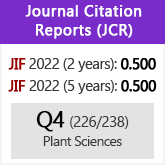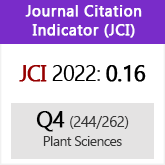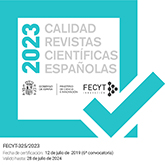Diversity, rarity and the evolution and conservation of the Canary Islands endemic flora
DOI:
https://doi.org/10.3989/ajbm.2008.v65.i1.244Keywords:
Canary Islands, endemism, species richness, range size rarity, threatened species richness, phylogenetic diversity, evolution, conservationAbstract
The endemic vascular flora of the Canary Islands comprises over 680, taxa collectively accounting for more than 50% of the total native flora. To investigate geographical patterns of diversity within the endemic flora, distribution data from published sources together with other field observation and herbarium data were used to compile a data matrix comprising the distributions of ca. 90% of endemic taxa scored on a 10 × 10km UTM grid. WORLDMAP was then used to investigate patterns of endemic diversity, range size rarity (a measure of endemicity), phylogenetic diversity and threatened taxon richness. Endemic taxon richness was found to be highly heterogeneous across the archipelago, with cells containing between one and 139 taxa each (0.05-22.82% of endemic diversity). Patterns of variation in range size rarity and phylogenetic diversity were found to be largely congruent with endemic diversity, although some cells exhibited markedly higher range size rarity scores than would be predicted by their endemic diversity scores. In contrast, the pattern of endangered taxon richness across the archipelago differed markedly from endemic taxon richness. Many cells in Lanzarote, Fuerteventura and Gran Canaria exhibit higher endangered taxon richness scores than would be predicted from their endemic richness scores whereas in Tenerife, El Hierro, La Palma and La Gomera, the converse is generally true. The implications of the results both for understanding the evolution of Canary Island endemic diversity and for the conservation of the region’s unique and vulnerable flora are considered.
Downloads
References
Albach, D.C., Meudt, H.M. & Oxelman, B. 2005. Piecing together the “new” Plantaginaceae. American Journal of Botany 92: 297-315. doi:10.3732/ajb.92.2.297
Allan, G.J., Francisco-Ortega, J., Santos-Guerra, A., Boerner, E. & Zimmer, E.A. 2004. Molecular phylogenetic evidence for the geographic origin and classification of Canary Island Lotus (Fabaceae: Loteae). Molecular Phylogenetics and Evolution 32: 123-138. doi:10.1016/j.ympev.2003.11.018
Al-Shehbaz, I.A., M.A. Beilstein & E.A. Kellogg. 2006. Systematics and phylogeny of the Brassicaceae (Cruciferae): an overview. Plant Systematics and Evolution 259: 89-120. doi:10.1007/s00606-006-0415-z
Angiosperm Phylogeny Group. 2003. An update of the Angiosperm Phylogeny Group classification for the orders and families of flowering plants: APG II . Botanical Journal of the Linnean Society 141: 399-436. doi:10.1046/j.1095-8339.2003.t01-1-00158.x
Bañares, A. Blanca, G., Güemes, J., Moreno, J.C. & Ortiz, S. (eds.). 2004. Atlas y Libro Rojo de la flora vascular amenazada de España. Dirección General de Conservación de la Naturaleza. Madrid.
Barber, J.C., Francisco-Ortega, J., Santos-Guerra, A., Turner, K.G. & Jansen, R.K. 2002. Origin of Macaronesian Sideritis L. (Lamioideae: Lamiaceae) inferred from nuclear and chloroplast sequence datasets. Molecular Phylogenetics and Evolution 23: 293-306. doi:10.1016/S1055-7903(02)00018-0
Barquín Diez, E. & Voggenreiter, V. 1988. Prodromus del atlas fitocorológico de las Canarias occidentales, Parte 1, Flora autóctona y especies de interés especial. Vols. 1-7.
Beltrán Tejera, E., Wildpret de la Torre, W., León Arencibia, M.C., García Gallo, A. & Reyes Hernández J. 1999. Libro Rojo de la flora canaria contenida en la Directiva-Hábitats europea. La Laguna.
Bramwell, D. 1972. Endemism in the flora of the Canary Islands. In: Valentine, D.H. (ed.), Taxonomy phytogeography and evolution: 141-159. Academic Press. London.
Bramwell, D. 1990. Conserving biodiversity in the Canary Islands. Annals of the Missouri Botanical Garden 77: 28-37. doi:10.2307/2399622
Bramwell, D. & Bramwell, Z.I. 2001. Wild flowers of the Canary Islands. Madrid.
Bremer, K. 1994. Asteraceae Cladistics and Classification. Portland.
Carine, M.A., Russell, S.J., Santos-Guerra, A. & Francisco-Ortega, J. 2004. Relationships of the Macaronesian and Mediterranean floras: Molecular evidence for multiple colonizations into Macaronesia and back-colonization of the continent in Convolvulus (Convolvulaceae). American Journal of Botany 91: 1070-1085. doi:10.3732/ajb.91.7.1070
Carracedo, J.C. & Day, S. 2002. Canary Islands: Classic Geology in Europe 4. Terra Publishing, Harpenden, Herts.
Castro Parga, I., Moreno Saiz, J.C., Humphries, C.J. & Williams, P.H. 1996. Strengthening the Natural and National Park system of Iberia to conserve vascular plants. Botanical Journal of the Linnean Society, 121: 189-206.
Coello, J., Cantagrel, J.M., Hernán, F., Fúster, J.M., Ibarrola, E., Ancochea, E., Casquet, C., Jamond, C., Díaz de Terán, J.-R. & Cendrero, A. 1992. Evolution of the eastern volcanic ridge of the Canary Islands based on new K-Ar data. J. Volcanol. Geotherm. Res. 53: 251-274. doi:10.1016/0377-0273(92)90085-R
de-Klerk, H.M., Fjeldså, J. Blyth, S. & Burgués, N.D. 2004. Gaps in the protected area network for threatened Afrotropical birds. Biological Conservation 117: 529-537. doi:10.1016/j.biocon.2003.09.006
del-Arco, M., Acebes, J.R., Pérez-de-Paz, P.L. & Marrero, M.C. 1999. Bioclimatology and climatophilous vegetation of Hierro (part 2) and La Palma (Canary Islands). Phytocoenologia 29(2): 253-290.
del-Arco, M., Salas, M., Acebes, J.R., Marrero, M.C., Reyes-Betancort, J.A. & Pérez de Paz 2002. Bioclimatology and climatophilous vegetation of Gran Canaria (Canary Islands). Annales Botanici Fennici 39: 15-41.
del-Arco, M., Pérez-de-Paz, P.L., Acebes, J.R., González-Mancebo, J.M., Reyes-Betancort, J.A., Bermejo, J.A., de-Armas, S. & González, R. 2006. Bioclimatology and climatophilous vegetation of Tenerife (Canary Islands). Annales Botanici Fennici 43: 167-192.
del-Valle, E., Maldonaldo, J., Sainz, H. & Sánchez de Dios, R. 2004. Áreas importantes para la flora amenazada española. In: Bañares, Á. & al. (eds.), Atlas y Libro Rojo de la flora vascular amenazada de España: 979-1007. Madrid.
Downie, S.R., Katz-Downie, D.S. & Watson, M.F. 2000. A phylogeny of the flowering plant family Apiaceae based on chloroplast DNA rpl16 and rpoC1 intron sequences: Towards a suprageneric classification of subfamily apioideae. American Journal of Botany 87: 273-292. doi:10.2307/2656915
Emerson, B.C. & Kolm, N. 2005. Species diversity can drive speciation. Nature 434: 1015-1017. doi:10.1038/nature03450
Faith, D.P. 1992. Conservation evaluation and phylogenetic diversity. Biological Conservation 61: 1-10. doi:10.1016/0006-3207(92)91201-3
Fior, S., Karis, P.O., Casazza, G., Minuto, L. & Sala, F. 2006. Molecular phylogeny of the Caryophyllaceae (Caryophyllales) inferred from chloroplast matK and nuclear rDNA ITS sequences. American Journal of Botany 93: 399-411. doi:10.3732/ajb.93.3.399
Forest, F., Grenyer, R., Rouget, M., Davies, T.J., Cowling, R.M., Faith, D.P., Balmford, A., Manning, J.C., Procheş, Ş., van der Bank, M., Reeves, G., Hedderson, T.A.J & Savolainen, V. 2007. Preserving the evolutionary potential of floras in biodiversity hotspots. Nature 445: 757-760. doi:10.1038/nature05587
Francisco-Ortega, J., Barber, J.C., Santos-Guerra, A., Febles-Hernandez, R. & Cansen, R.K. 2001. Origin and evolution of the endemic genera of Gonosperminae (Asteraceae: Anthemideae) from the Canary Islands: evidence from nucleotide sequences of the internal transcribed spacers of the nuclear ribosomal DNA. American Journal of Botany 88: 161-169. doi:10.2307/2657136
Gaisberg, M. von & Stierstorfer, C. 2005. The significance of ecological traits for the speciation of endemic angiosperms on El Hierro (Canary Islands). Phytocoenologia 35: 39-52. doi:10.1127/0340-269X/2005/0035-0039
Gobierno de Canarias. 2000. Decreto Legislativo 1/2000, de 8 de mayo, por el que se aprueba el Texto Refundido de las Leyes de Ordenación del Territorio de Canarias y de Espacios Naturales de Canarias. Boletín Oficial de Canarias 60: 5989-6307.
Gobierno de Canarias. 2001. Decreto 151/2001, de 23 de julio, por el que se crea el Catálogo de Especies Amenazadas de Canarias. Boletín Oficial de Canarias 97: 11101-11111.
Gómez Campo, C. 1996. Libro Rojo de especies vegetales amenazadas de las Islas Canarias. Gobierno de Canarias. Grass Phylogeny Working Group. 2001. Phylogeny and subfamilial classification of the grasses (Poaceae). Annals of the Missouri Botanical Garden 88: 373-457.
Guillou, H., Carracedo, J.C., Pérez Torrado, F.J. & Rodríguez Badiola, E. 1996. K-Ar ages and magnetic stratigraphy of a hotspot-induced, fast grown oceanic island: El Hierro, Canary Islands. Journal of Volcanology and Geothermal Research 78: 239-250.
Harley, R.M., Atkins, S., Budantsev, A.L., Cantino, P.D., Conn, B.J., Grayer, R., Harley, M.M., de Kok, R., Krestovskaja, T., Morales, R., Paton, A.J., Ryding, O. & Upson, T. 2004. Labiatae. In: Kadereit, J.W. (ed.), The families and genera of vascular plants, Vol. VII, Lamiales: 167-282. Berlin.
Helfgott, D.M., Francisco-Ortega, J., Santos-Guerra, A., Jansen, R.K. & Simpson, B.B. 2000. Biogeography and breeding system evolution of the woody Bencomia alliance (Rosaceae) in Macaronesia based on ITS sequence data. Systematic Botany 25: 82-97. doi:10.2307/2666675
Hulbert, A.H. & Jetz, W. 2007. Species richness, hotspots and scale dependence of range maps in ecology and conservation. Proceedings of the Nacional Academy of Sciences of the United States of America 104: 13384-13389. doi:10.1073/pnas.0704469104
Humphries, C.J. 1979. Endemism and evolution in Macaronesia. In: Bramwell, D. (ed.), Plants and Islands: 171-200. London. Humphries, C., Araujo, M., Williams, P., Lampinen, R., Lahti, T. & Uotila, P. 1999. Plant diversity in Europe: Atlas Florae Europaeae and WORLDMAP. Acta Botanica Fennica 162: 11-21.
Kadereit, G., Borsch, T., Weising, K. & Freitag, H. 2003. Phylogeny of Amaranthaceae and Chenopodiaceae and the Evolution of C4 Photosynthesis. International Journal of Plant Sciences 164: 959-986 doi:10.1086/378649
Kim, S.-Ch., Crawford, D.J., Francisco-Ortega, J. & Santos- Guerra, A. 1996. A common origin for woody Sonchus and five related genera in the Macaronesian islands: Molecular evidence for extensive radiation. Proceedings of the Nacional Academy of Sciences of the United States of America 93: 7743- 7748. doi:10.1073/pnas.93.15.7743
Lamoreux, J.F., Morrison, J.C., Ricketts, T.H., Olson, D.M., Dinerstein, E., McKnight, M.W. & Shugart, H.H. 2006. Global tests of biodiversity concordance and the importance of endemism. Nature 440: 212-214. doi:10.1038/nature04291
Langhammer, P.F., Bakarr, M.I., Bennun, L.A., Brooks, T.M., Clay, R.P., Darwall, W., Silva, N. de, Edgar, G.J., Eken, G., Fishpool, L.D.C., Fonseca, G.A.B. da, Foster, M.N., Knox, D.H., Matiku, P., Radford, E.A., Salaman, P., Sechrest, W. & Tordoff, A.W. 2007. Identification and gap analysis of key biodiversity areas: targets for comprehensive protected area systems. Gland.
Lewis, B., Schrire, B. Mackinder & Lock, M. (eds). 2005. Legumes of the World. London.
Lledó, M.L., Crespo, M.P., Fay, M.F. & Chase, M.W. 2005. Molecular phylogenetics of Limonium and related genera (Plumbaginaceae): biogeographical and systematic implications. American Journal of Botany 92: 1189-1198. doi:10.3732/ajb.92.7.1189
Mort, M.E., Soltis, D.E., Soltis, P.S., Francisco-Ortega, J. & Santos-Guerra, A. 2002. Phylogenetics and evolution of the Macaronesian clade of Crassulaceae inferred from nuclear and chloroplast sequence data. Systematic Botany 27: 271- 288.
Orme, C.D.L., Davies, R.G., Burgess, M., Eigenbrod, F., Pickup, N., Olson, V.A., Webster, A.J., Ding, T-S., Rasmussen, P.C., Ridgely, R.S., Stattersfield, A.J., Bennett, P.M., Blackburn, T.M., Gaston, K.J. & Owens, I.P.F. 2005. Global hotspots of species richness are not congruent with endemism or threat. Nature 436: 1016-1019. doi:10.1038/nature03850
Panero, J.L., Francisco-Ortega, J., Jansen, R.K. & Santos-Guerra, A. 1999. Molecular evidence for multiple origins of woodiness and a New World biogeographic connection of the Macaronesian Island endemic Pericallis (Asteraceae: Senecioneae). Proceedings of the Nacional Academy of Sciences of the United States of America 96: 13886-13891. doi:10.1073/pnas.96.24.13886
Pereira, H.M., Vânia, M.P. & Vicente, L. 2007. Does species diversity really drive speciation? Ecography 30: 328-330. doi:10.1111/j.0906-7590.2007.04779.x
Polasky, S., Csuti, B., Vossler, C.A. & Meyers, S.M. 2001. A comparison of taxonomic distinctiveness versus richness as criteria for setting conservation priorities for North American birds. Biological Conservation 97: 99-105. doi:10.1016/S0006-3207(00)00103-8
Quézel, P. & Medail, F. 1995. La région circuí-méditerranéene, centre mundial majeur de biodiversité végétale. In: Actes des 6èmes rencontres de l’Agence Régionale pour l’Environment, Provence-Alpes-Côte d’Azur: 152-160. Gap.
Reyes-Betancort, J.A., Wildpret, W. & León Arencibia, M.C. 1998. El paisaje vegetal de Lanzarote a partir de fuentes escritas (siglos XV-XX). Anuario del Instituto de Estudios Canarios 43: 31-54.
Reyes-Betancort, J.A., Wildpret, W. & León Arencibia, M.C. 2001. The vegetation of Lanzarote (Canary Islands). Phytocoenologia 31(2): 185-247.
Rivas-Martínez, S. 2007. Mapas de series, geoseries y geopermaseries de vegetación de España [Memoria del mapa de vegetación potencial de España], Parte I. Itinera Geobotánica 17: 1-435.
Rodrigues, A.S.L. & Gaston, K.J. 2001. How large do reserve networks need to be? Ecology Letters 4: 602-609. doi:10.1046/j.1461-0248.2001.00275.x
Rodríguez Delgado, O. 2005. El Paisaje Vegetal. In: Rodríguez Delgado (ed.), Patrimonio Natural de la Isla de Fuerteventura. Excmo. Cabildo de Fuerteventura, Gobierno de Canarias y Centro de la Cultura Popular Canaria.
Rodríguez Delgado, O., García Gallo, A. & Reyes-Betancort, J.A. 2000. Estudio fitosociológico de la vegetación actual de la isla de Fuerteventura. Vieraea 28: 61-98.
Santos Guerra, A. 2001. Flora vascular nativa. In: Fernández-Palacios, J.M. & Martín Esquivel, J.L., Naturaleza de las Islas Canarias, Ecología y Conservación: 185-192. Santa Cruz de Tenerife.
Stierstorfer, C. & Gaisberg, M. von. 2006. Annotated checklist and distribution of the vascular plants of El Hierro, Canary Islands, Spain. Englera 27: 1-221.
Suárez, C. 1994. Estudio de los relictos actuales del monte verde en Gran Canaria. Cabildo Insular de Gran Canaria. Las Palmas de Gran Canaria.
Sundseth, K. 2005. Natura 2000 in the Macaronesian region. Luxembourg. Susanna, A., Garnatje, T. & García-Jacas, N. 1999. Molecular phylogeny of Cheirolophus (Asteraceae: Cardueae-Centaureinae) based on ITS sequences of nuclear ribosomal DNA. Plant Systematics and Evolution 214: 147-160.
Trusty, J.L. Olmstead, R.G., Santos Guerra, A., Sá-Fontinha, S. & Francisco-Ortega, J. 2005. A chloroplast and nuclear DNA based phylogeny of the Macaronesian endemic genus Bystropogon L’Her. (Lamiaceae): paleoislands, ecological shifts and inter-island colonizations. Molecular Ecology 14: 1177-1189.
Vane-Wright, R.I., Humphries, C.J. & Williams, P.H. 1991. What to protect?–Systematics and the agony of choice. Biological Conservation 55: 235-254. doi:10.1016/0006-3207(91)90030-D
Väre, H., Lampinen, R., Humphries, C. & Williams, P. 2003. Taxonomic diversity of vascular plants in the European alpine areas. In: Nagy, L. & al. (eds.), Alpine Biodiversity in Europe: 133- 148. Berlin.
Whittaker, R.J., Ladle, R.J., Araújo, M.B., Fernández-Palacios, J.M., Domingo Delgado J. & Arévalo J.R. 2007. The island immaturity-speciation pulse model of island evolution: an alternative to the ‘‘diversity begets diversity’’ model. Ecography 30: 321-327. doi:10.1111/j.0906-7590.2007.04761.x
Williams, P.H., Prance, G.T., Humphries, C.J. & Edwards, K.S. 1996. Promise and problems in applying quantitative complementary areas for representing the diversity of some Neotropical plants (families Dichapetalaceae, Lecythidaceae, Caryocaraceae, Chrysobalanaceae and Proteaceae). Biological Journal of the Linnean Society 58: 125-157.
Williams, P.H. 2003. WORLDMAP version 4.20.24. Biogeography and Conservation Lab, The Natural History Museum, Cromwell Road. London.
Downloads
Published
How to Cite
Issue
Section
License
Copyright (c) 2008 Consejo Superior de Investigaciones Científicas (CSIC)

This work is licensed under a Creative Commons Attribution 4.0 International License.
© CSIC. Manuscripts published in both the printed and online versions of this Journal are the property of Consejo Superior de Investigaciones Científicas, and quoting this source is a requirement for any partial or full reproduction.All contents of this electronic edition, except where otherwise noted, are distributed under a “Creative Commons Attribution 4.0 International” (CC BY 4.0) License. You may read here the basic information and the legal text of the license. The indication of the CC BY 4.0 License must be expressly stated in this way when necessary.
Self-archiving in repositories, personal webpages or similar, of any version other than the published by the Editor, is not allowed.

















